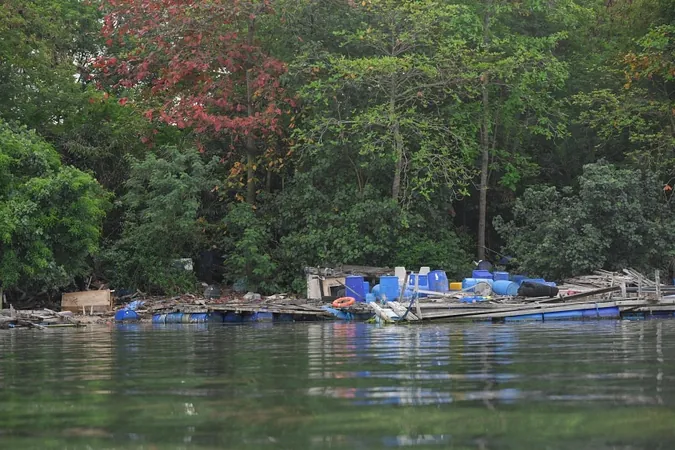
Stray Debris on Pulau Ketam Sparks Concerns Over Abandoned Fish Farms and Environmental Impact
2024-10-26
Author: Arjun
Overview
SINGAPORE – An increasing amount of abandoned fish farm structures, barges, large wooden planks, and even a derelict boat has been discovered along the southern shoreline of Pulau Ketam, near Pulau Ubin. This concerning sight was reported during a visit by The Straits Times in early October, as remnants of the fish farming industry become progressively more visible, especially at low tide.
Government Action
The Singapore Food Agency (SFA) has acknowledged the growing clutter and plans to initiate a cleanup operation that is expected to be completed by December, subject to weather conditions and volunteer availability. A representative noted, "Dismantling and proper disposal of these structures are in our plans. SFA is collaborating with coastal farms to manage their farm structures and ensure that all loose equipment is secured."
Fish Farm Operator Responsibility
While the SFA refrained from classifying the debris as illegal dumping, the fish farm operator identified as Mr. Phillip Lim, owner of Sea Angel Marine, has been linked to the disarray. He is reportedly taking steps to secure drifting structures temporarily along the coast to mitigate navigational hazards.
Associated Structures
Among the clutter lies a substantial farm structure inscribed with the number FC110E, associated with Ocean King Harvest—previously known as Sea Angel Marine. Importantly, as of October, both this farm and another imprinted with “FC63E” registered to a Mr. Lim Swa Sheng were no longer listed in the farm licensing records, indicating their withdrawal from the fish farming sector.
Expert Opinions
Experts, including Dr. Tay Choon Nghee from Prime Group International, noted that the situation has worsened over recent months, likely a consequence of numerous fish farms relocating from the East Johor Strait. Current statistics reveal a decline in the number of fish farms in the region, plummeting from 98 in 2023 to just 74 as of early October.
Environmental Concerns
Marine conservationists are voicing alarms regarding potential environmental repercussions from the abandoned structures. Ms. Sue Ye, founder of Marine Stewards, highlighted the risks of materials leaching into nearby waters, adversely affecting local biodiversity. Notably, Yasser Amin, chief officer of Stridy, emphasized that the sizeable debris—comprising large rafts built from wooden structures and barrels—requires professional intervention for safe removal, something beyond the capabilities of voluntary cleanup operations.
Cost of Cleanup
Furthermore, Ivan Francis Danakody from Singapore Salvage Engineers stated that dismantling and disposing of these structures can be highly costly, with an estimate of $60,000 to $70,000 per structure. The complexity of the task necessitates specialized equipment, such as crane barges, to manage the debris effectively.
Broader Implications
The situation serves as a stark reminder of the waste generated by Singapore’s fish farms, including both organic refuse and materials from aging structures. This incident has revived discussions concerning the sustainability practices of fish farming and the responsibility of operators to maintain ecological stability amidst their operations.
Conclusion
As this pressing environmental issue unfolds, it begs the question: How will Singapore address the growing concerns about abandoned marine infrastructures and protect its coastal ecosystems? Stay tuned as we monitor the developments in this ongoing story.

 Brasil (PT)
Brasil (PT)
 Canada (EN)
Canada (EN)
 Chile (ES)
Chile (ES)
 España (ES)
España (ES)
 France (FR)
France (FR)
 Hong Kong (EN)
Hong Kong (EN)
 Italia (IT)
Italia (IT)
 日本 (JA)
日本 (JA)
 Magyarország (HU)
Magyarország (HU)
 Norge (NO)
Norge (NO)
 Polska (PL)
Polska (PL)
 Schweiz (DE)
Schweiz (DE)
 Singapore (EN)
Singapore (EN)
 Sverige (SV)
Sverige (SV)
 Suomi (FI)
Suomi (FI)
 Türkiye (TR)
Türkiye (TR)